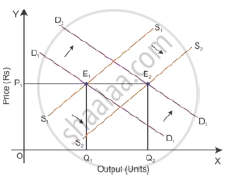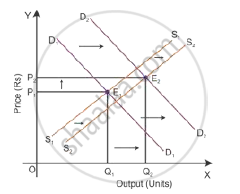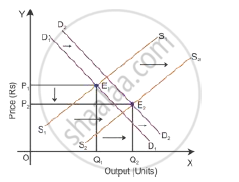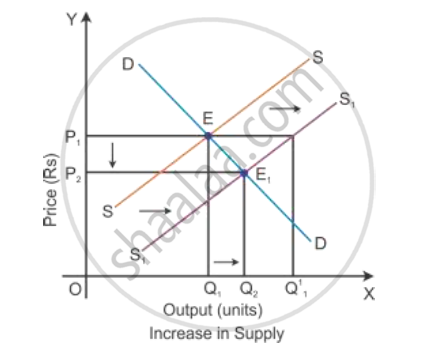Advertisements
Advertisements
Questions
A market for a good is in equilibrium. There is simultaneous "increase" both in demand and supply of the good. Explain its effect on the market price
Market for a good is in equilibrium. Supply of the good 'increases'. Explain the chain of effects of this change.
Solution 1
When there is a simultaneous increase in demand and supply, the equilibrium point of price of output will depend on the basis of proportion of changes in demand and supply.
Let us understand the effects through the following conditions:
i. If increase in demand is equal to increase in supply
When the demand increases from D1D1 to D2D2 and the supply increases from S1S1 to S2S2 in the same proportion, the new equilibrium price will be OP1 and the new equilibrium output will be OQ2. This new price and output intersect each other at Point E2 and will arrive at new equilibrium. As the increase in demand is equal to the increase in supply, the price remains the same at the new equilibrium point.

ii. If increase in demand is more than increase in supply
When the demand increases, the demand curve will shift to D2D2 and the increase in supply will shift the supply curve to S2S2. Here, the increase in demand is more than the supply; hence, there will be a new equilibrium price and a new equilibrium output which intersects at Point E2. As the increase in demand is more than the decrease in supply, the equilibrium price increases at the new equilibrium point.

iii. If increase in demand is less than increase in supply
When the demand increases, the demand curve will shift to D2D
When there is a simultaneous increase in demand and supply, the equilibrium point of price of output will depend on the basis of proportion of changes in demand and supply.
Let us understand the effects through the following conditions:
i. If increase in demand is equal to increase in supply
When the demand increases from D1D1 to D2D2 and the supply increases from S1S1 to S2S2 in the same proportion, the new equilibrium price will be OP1 and the new equilibrium output will be OQ2. This new price and output intersect each other at Point E2 and will arrive at new equilibrium. As the increase in demand is equal to the increase in supply, the price remains the same at the new equilibrium point.

ii. If increase in demand is more than increase in supply
When the demand increases, the demand curve will shift to D2D2 and the increase in supply will shift the supply curve to S2S2. Here, the increase in demand is more than the supply; hence, there will be a new equilibrium price and a new equilibrium output which intersects at Point E2. As the increase in demand is more than the decrease in supply, the equilibrium price increases at the new equilibrium point.

iii. If increase in demand is less than increase in supply
When the demand increases, the demand curve will shift to D2D2 and the increase in supply will shift the supply curve to S2S2. Here, the increase in demand is less than the supply; hence, there will be a new equilibrium price and a new equilibrium output which intersects at Point E2. As the increase in demand is less than the increase in supply, the equilibrium price decreases at the new equilibrium point.

Solution 2
Consider DD to be the initial demand curve and SS to be the supply curve of the market. Market equilibrium is achieved at Point E, where the demand and supply curves intersect each other. Therefore, the equilibrium price is OP, and the equilibrium quantity demanded is OQ.
When there is the change in other factors than price, there will be the rise in the supply of goods. There will be a shift in the supply curve towards the right to SS1 with an increase in the supply, and the demand curve DD will remain the same. This implies that there will be a situation of excess supply at the equilibrium point.

In the above diagram, there is an excess supply of OQ1 to OQ11 units of output at the initial price OP1. Thereby the producers will tend to reduce the price of the output to increase the sale in the market. A profit margin of the firm will come down and slowly some of the firms will tend to quit the market. Because of this, the market supply will decline to OQ2 level of output and the price of the output also gets reduced to the point OP2. Now, the new market equilibrium will be at Point E1, where the new supply curve SS1 intersects the demand curve DD.
APPEARS IN
RELATED QUESTIONS
Market for a good is in equilibrium. There is simultaneous "decrease" both in demand and supply of the good. Explain its effect on market price
A market for a good is in equilibrium. The demand for the good 'increases'. Explain the chain of effects of this change.
A market for a product is in equilibrium. Demand for the product "decreases." Explain the chain of effects of this change till the market again reaches equilibrium. Use diagram
Explain its chain of effects on the market of that good. Use diagram
Draw average revenue and marginal revenue curves in a single diagram of a firm which can sell more units of a good only by lowering the price of that good. Explain.
Market for a good is in equilibrium. There is an ‘increase’ in demand for this good. Explain the chain of effects of this change. Use diagram.
What will happen if the price prevailing in the market is
(i) above the equilibrium price?
(ii) below the equilibrium price?
How are equilibrium price and quantity affected when income of the consumers increase.
Using supply and demand curves, show how an increase in the price of shoes affects the price of a pair of socks and the number of pairs of socks bought and sold.
How will a change in price of coffee affect the equilibrium price of tea? Explain the effect on equilibrium quantity also through a diagram.
How do the equilibrium price and the quantity of a commodity change when price of input used in its production changes?
Compare the effect of shift in the demand curve on the equilibrium when the number of firms in the market is fixed with the situation when entry-exit is permitted.
Considering the same demand curve as in exercise 22, now let us allow for free entry and exit of the firms producing commodity X. Also assume the market consists of identical firms producing commodity X. Let the supply curve of a single firm be explained as
qSf = 8 + 3p for p ≥ 20
= 0 for 0 ≤ p < 20
(a) What is the significance of p = 20?
(b) At what price will the market for X be in equilibrium? State the reason for your answer.
(c) Calculate the equilibrium quantity and number of firms.
Answer the following question.
Show with the help of diagrams, the effect on equilibrium price and quantity when:
There is a fall in the price of substitute goods.
Rate of interest on savings account is more than that on recurring account.
